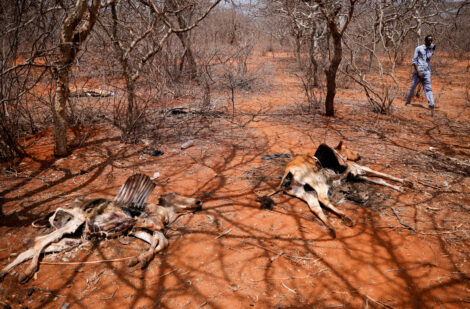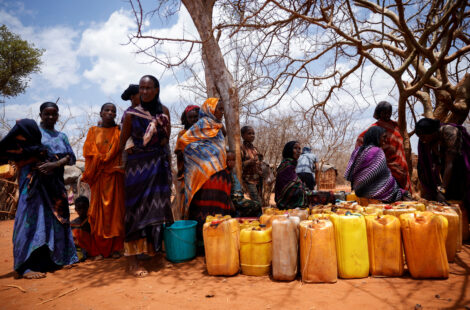In southern Ethiopia, drought kills livestock amid fears of what comes next

A man walks past carcasses of cows in Kura Kalicha camp for the people internally displaced by drought near Das town, Oromiya region, Ethiopia, March 7, 2023. REUTERS/Tiksa Negeri
KURA KALICHA, Ethiopia — After three years of failed rains, the animals in the southern Ethiopian village of Kura Kalicha are dying. Dozens of decomposing cattle carcasses lie on the parched earth, their flesh picked over by scavengers.
Jilo Wile, a local government official, fears the villagers will be next to succumb to the drought. More than 100 local residents are in hospital in critical condition from malnutrition, he said.
“This number includes children, elders, and pregnant women,” said Jilo, who has lost 73 of his 75 cows to starvation.
Like its neighbors Somalia and Kenya, southern Ethiopia is enduring the Horn of Africa’s worst drought in decades. Five consecutive rainy seasons have failed and the one underway is expected to as well, prompting warnings from aid agencies that more help is needed to head off a humanitarian crisis.
Nearly 12 million people, a tenth of the population, are estimated to be food insecure in Ethiopia’s drought-affected areas, according to the United Nations, which defines insecurity as a lack of regular access to the safe and nutritious food needed for growth, development and daily life.
Somalia has been hit the hardest with the drought claiming an estimated 43,000 lives last year, but still short of the famine many aid workers had predicted.
No fatalities have yet been directly attributed to the drought in the Oromiya region, where Kura Kalicha is located, or the neighboring drought-affected regions of Ethiopia, but humanitarian workers expect it will not be long.
“Collectively, as communities they have run out of coping mechanisms,” said Kate Maldonado from international aid agency Mercy Corps, who recently visited southern Ethiopia’s Somali region.
The population across much of southern Ethiopia’s lowlands relies overwhelmingly on its livestock, with diets supplemented by basic crops like maize.
Locals said the aid on offer has been insufficient and slow to arrive. Ethiopia’s federal government last month issued a statement saying they were working with aid organizations to help those in need.

Women wait for a water truck in Kura Kalicha camp for the people internally displaced by drought near Das town, Oromiya region, Ethiopia, March 7, 2023. REUTERS/Tiksa Negeri
A spokesperson for the federal government did not respond to a request for comment. Oromiya regional government spokesperson Hailu Aduga said authorities had reacted promptly.
“The aid is not enough given the number of those who are in need. But we have been working to avoid a loss of human life,” he told Reuters.
Everyone agrees the available resources are inadequate. Last year, Ethiopia received only half of the $3.34 billion required for humanitarian needs, including the drought, but also the fallout from the two-year war in the northern region of Tigray, which ended last November after tens of thousands of deaths.
“If we don’t scale up our assistance, it won’t be possible to prevent the looming hunger crisis from affecting children, girls and their families,” said Mudasser Siddiqui, country director for Plan International, a child rights organization.
Jilo Guracha, a 40-year-old a mother of seven, walked 85 kilometers (53 miles) in the scorching head to reach a camp where she and two of her sons could receive food rations.
The camp, in the Dubuluk district, was set up a year ago in an empty field, and now hosts 53,000 people who live in small huts made from grass and used plastic bags.
“Some are committing suicide after failing to provide for their family,” she said. “We beg the government to save us from dying of hunger until God brings us rain.”
RELATED STORIES
Drought is killing Kenya’s endangered wildlife
Zimbabwe’s severe drought killing elephants, other wildlife